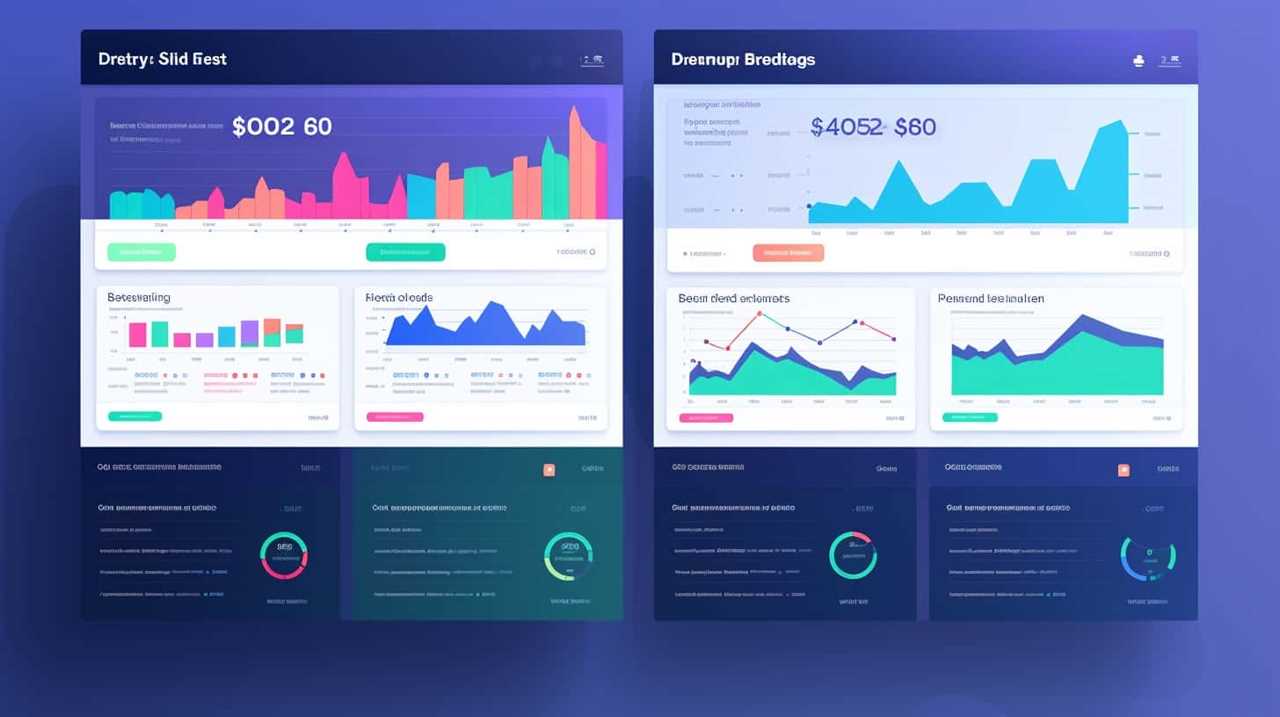Keyword Research
Decoding Niche Markets: How Consumer Behavior Is Shaped

In our examination of consumer behaviors, we unearth the enigmatic world of niche markets. These concealed sectors present substantial possibilities for companies seeking to thrive in an ever-evolving landscape.
Understanding the intricacies of niche consumers is key to unlocking their purchasing power. In this article, we will explore the factors that shape consumer behavior in niche markets.
Through analytical insights and data-driven analysis, we will decode the secrets behind their decision-making processes, providing invaluable knowledge for those striving for mastery in this realm.
Key Takeaways
- Understanding niche markets and consumer segmentation is essential for marketers to tailor their strategies and increase brand loyalty and profitability.
- Social media platforms like Instagram and TikTok have a significant impact on consumer behavior, and influencer marketing is a powerful tool for reaching a wider audience.
- Cultural influences, including traditions and societal norms, greatly impact consumer preferences, and marketers need to align their products and messages accordingly.
- Personal preferences and customization play a crucial role in shaping consumer behavior, and marketers should focus on personalization and creating tailored experiences to resonate with niche consumers.
Understanding Niche Markets
We will explore how niche markets are understood and shaped by consumers.

Understanding niche markets involves a deep analysis of consumer segmentation and niche market dynamics.
Consumer segmentation is the process of dividing a broad market into smaller, distinct groups based on similar characteristics, needs, and preferences. This segmentation enables marketers to identify specific target audiences within niche markets and tailor their marketing efforts accordingly.
Niche market dynamics refer to the unique forces and trends that shape the behavior and preferences of consumers within these specialized markets. By studying these dynamics, marketers gain valuable insights into consumer motivations, purchase patterns, and the factors that influence their decision-making process.
This data-driven approach allows marketers to develop effective strategies to engage with niche market consumers, ultimately leading to increased brand loyalty and profitability.

Factors Influencing Consumer Behavior
When it comes to understanding consumer behavior, there are several key factors that play a significant role.
First, social media has had a profound impact on shaping consumer behavior, with platforms like Instagram and TikTok influencing purchasing decisions and brand preferences.
Additionally, cultural influences, such as traditions, values, and societal norms, can greatly impact consumer behavior, as individuals tend to gravitate towards products and services that align with their cultural identity.
Lastly, personal preferences, including individual tastes, preferences, and lifestyle choices, also play a crucial role in shaping consumer behavior.

Social Media Impact
As social media continues to shape consumer behavior, it’s important to understand the factors that influence purchasing decisions.
In today’s digital age, influencers have a significant impact on consumer behavior. These individuals, who’ve large followings on platforms like Instagram and YouTube, have the power to sway consumer opinions and drive purchasing decisions. Companies are increasingly leveraging this influencer impact by incorporating influencer marketing into their strategies. By partnering with influencers, brands can tap into their loyal fan base and reach a wider audience.
Additionally, viral marketing has also become a key factor in consumer behavior. Through the power of social media, content can quickly spread and go viral, capturing the attention of millions. Brands that are able to create compelling and shareable content have a greater chance of influencing consumer behavior and driving sales.
Cultural Influences
One factor that significantly shapes consumer behavior is the influence of cultural factors. Cultural diversity plays a crucial role in shaping consumer behavior as it encompasses various aspects like values, beliefs, attitudes, and traditions that differ across different cultures. Cross-cultural marketing recognizes the importance of understanding these cultural differences and tailoring marketing strategies to specific cultural groups.

To fully grasp the impact of cultural influences on consumer behavior, it’s essential to consider the following subtopics:
- Cultural values and norms: Understanding the core values and norms of a particular culture helps marketers align their products and messages with the cultural preferences and expectations of consumers.
- Language and communication: Language is an integral part of culture, and effective communication requires understanding cultural nuances and idioms. Marketers need to adapt their marketing messages to resonate with different cultures, ensuring effective communication.
Personal Preferences
Our understanding of consumer behavior is enriched when we consider the personal preferences that influence individuals’ purchasing decisions. Personalization in marketing and customization in products play significant roles in shaping these preferences.
In today’s market, consumers are increasingly seeking products and services that cater to their unique needs and desires. They want to feel special and valued, and personalization allows marketers to create tailored experiences that resonate with consumers on a deeper level. By offering customizable products, businesses give consumers the freedom to design and create something that aligns perfectly with their tastes and preferences. This level of personalization fosters a sense of ownership and emotional connection, leading to increased customer satisfaction and loyalty.
Understanding and responding to personal preferences is crucial for businesses looking to tap into niche markets and establish long-lasting relationships with their customers.

Transition: Now that we’ve explored the impact of personal preferences on consumer behavior, let’s delve into the psychological influences that shape niche consumers’ purchasing decisions.
Psychological Influences on Niche Consumers
When examining psychological influences on niche consumers, it’s crucial to understand the power of subconscious triggers in marketing. These subconscious triggers, such as colors, symbols, and even scents, can evoke certain emotions and shape consumer behavior without their conscious awareness.
Additionally, emotional factors play a significant role in influencing niche consumers’ decision-making processes. By tapping into consumers’ emotions and creating a strong emotional connection with the brand or product, marketers can effectively sway niche consumers towards their offerings.
Subconscious Triggers in Marketing
As marketers, we harness the power of subconscious triggers to influence the purchasing decisions of niche consumers. By understanding consumer behavior psychology and employing subconscious branding techniques, we can tap into the hidden drivers that motivate individuals to make specific choices.

Here are two important subtopics to explore:
- Emotional appeal:
- Emotions play a significant role in consumer decision-making.
- By evoking specific emotions through branding, such as nostalgia or happiness, marketers can create a deeper connection with niche consumers.
- Social proof:
- People tend to follow the actions of others, especially when they’re uncertain.
- By showcasing testimonials, reviews, and endorsements from trusted sources, marketers can leverage social proof to influence niche consumers’ decisions.
Understanding and utilizing these subconscious triggers can help marketers effectively target and engage niche consumers, increasing the success of their marketing campaigns.
Emotional Factors Influencing Behavior
To further explore emotional factors influencing behavior in niche consumers, we delve into the profound impact of these psychological influences on their decision-making process. Emotional triggers play a crucial role in consumer psychology, affecting their purchasing decisions and brand loyalty. Understanding these triggers can provide valuable insights into niche markets and help businesses tailor their marketing strategies accordingly.
Consumer psychology research has shown that emotions strongly influence consumer behavior. When consumers experience positive emotions, such as happiness or excitement, they’re more likely to make impulsive purchases. On the other hand, negative emotions, such as fear or sadness, can lead to avoidance behaviors or a desire for products that offer comfort or relief.

By tapping into the emotional triggers of niche consumers, businesses can create targeted marketing campaigns that resonate with their unique needs and desires. This means understanding the specific emotions that drive their decision-making and crafting messages and experiences that evoke those emotions.
Cultural Influences on Niche Consumers
Our understanding of niche consumers is enriched by recognizing the cultural influences that shape their consumer behavior. The influence of traditions and the impact of cultural identity play significant roles in shaping the preferences and choices of niche consumers.
Cultural Influences on Niche Consumers:
- Traditions:
Traditional customs and practices passed down through generations influence the consumption patterns of niche consumers. These traditions can dictate the types of products or services that niche consumers are more likely to purchase. - Cultural Identity:
Niche consumers often align their consumption choices with their cultural identity. Cultural identity can influence niche consumers’ preferences for certain brands, styles, or experiences.
Understanding these cultural influences is crucial for businesses targeting niche markets. By tailoring their products or marketing strategies to align with the traditions and cultural identities of niche consumers, businesses can effectively tap into these markets and build strong connections with their target audience.

Social Influences on Niche Consumers
Exploring the social dynamics that shape niche consumers’ behavior, we uncover the influence of peer groups and social networks.
In today’s digital age, social media platforms have become powerful tools for influencing consumer decisions. Influencer marketing has emerged as a key strategy for brands to tap into niche markets.
By partnering with influencers who have a strong following and credibility within a specific niche, brands can effectively reach and persuade niche consumers. These influencers have the ability to create a sense of trust and authenticity, making their recommendations highly influential.
Additionally, peer pressure plays a significant role in shaping niche consumers’ behavior. When individuals see their peers engaging with certain products or brands, they are more likely to follow suit in order to fit in and be accepted within their social circles.

As such, understanding and leveraging social influences is crucial for brands seeking to capture the attention and loyalty of niche consumers.
Demographic Influences on Niche Consumers
When it comes to understanding niche consumers, demographic influences play a crucial role. Age and preferences go hand in hand, as different age groups have distinct preferences and behaviors when it comes to consumer products.
For example, younger consumers may be more inclined towards technology-based products, while older consumers may prefer more traditional options. Gender also plays a significant role in shaping purchasing habits, as studies have shown that men and women tend to have different preferences and priorities when it comes to their buying decisions.
Age and Preferences
In understanding niche markets, one must consider the influence of age and preferences on consumer behavior. Age plays a significant role in determining purchasing power and generational preferences. Here are two key points to consider:

- Age and purchasing power:
- Different age groups have varying levels of disposable income, which affects their ability to spend on niche products and services.
- The younger generation, such as millennials and Gen Z, tend to have lower purchasing power due to factors like student loans and entry-level salaries.
- Generational preferences:
- Each generation has distinct preferences and values, which influence their buying decisions.
- For example, millennials are more likely to prioritize sustainability and ethical sourcing when choosing niche products.
Understanding the nuances of age and preferences allows businesses to tailor their marketing strategies to target specific generations effectively.
Transitioning to the subsequent section about ‘gender and purchasing habits’, we delve into another important demographic influence on niche consumers.
Gender and Purchasing Habits
Now let’s delve into how gender influences niche consumers’ purchasing habits and shapes consumer behavior.
Gender stereotypes play a significant role in shaping consumer preferences and the way individuals make purchasing decisions. Research has shown that there are distinct differences in the buying behavior of men and women.

For example, women are often associated with being more price-conscious and value-oriented, while men tend to be more focused on functionality and brand prestige. These stereotypes can impact the types of products and brands that individuals gravitate towards.
Understanding these gender-based preferences can provide valuable insights for businesses looking to target niche markets. By tailoring their marketing strategies to align with these preferences, companies can effectively capture the attention and loyalty of their target customers.
Niche Market Segmentation Strategies
Our research has identified several effective niche market segmentation strategies that can be implemented to target specific consumer groups. When it comes to niche market targeting, it’s crucial to understand the unique needs and preferences of the target audience.
Here are two sub-lists of niche market segmentation strategies that have proven to be effective marketing strategies:

- Demographic Segmentation:
- Age: Tailoring products and messaging to different age groups.
- Location: Targeting consumers based on their geographical location and local preferences.
- Psychographic Segmentation:
- Lifestyle: Identifying and targeting consumers with similar lifestyles and values.
- Interests: Segmenting consumers based on their specific interests and hobbies.
Branding and Messaging for Niche Consumers
To effectively engage niche consumers, businesses must craft branding and messaging that resonates with their unique needs and preferences. A strong brand identity is essential in capturing the attention of niche consumers. It conveys the values, personality, and purpose of the brand, creating a connection and building trust.
Targeted advertising plays a crucial role in reaching niche consumers effectively. By understanding their specific interests, demographics, and behaviors, businesses can tailor their messaging to speak directly to this audience. This can be achieved through personalized content, using language and visuals that resonate with the niche market. By doing so, businesses can establish themselves as experts in the field, building credibility and loyalty among niche consumers.
Transitioning into the subsequent section on niche market research and analysis, understanding the intricacies of niche consumers is vital for developing effective branding and messaging strategies.
Niche Market Research and Analysis
Conducting thorough niche market research and analysis is crucial for understanding consumer behavior and shaping effective marketing strategies. By targeting specific niche markets, businesses can tailor their products and services to meet the unique needs and preferences of these consumers. This allows companies to differentiate themselves from competitors and establish a strong market presence.

To successfully conduct niche market research and analysis, businesses should consider the following strategies:
- Identify the target niche market: Determine the specific segment of consumers that the business wants to target. This could be based on demographics, psychographics, or other factors.
- Gather data and insights: Collect and analyze relevant data to gain a deep understanding of the target niche market. This can include market trends, consumer preferences, and buying behaviors.
Consumer Decision-Making Processes in Niche Markets
In the realm of niche markets, the consumer decision-making processes play a pivotal role in shaping purchasing behaviors. Understanding how consumers make decisions in these specialized markets is crucial for businesses looking to effectively target niche consumers.
Consumer decision making in niche markets is often driven by factors such as personal values, lifestyle preferences, and specific needs that aren’t adequately met by mainstream products or services. Research shows that niche consumers tend to engage in extensive information search and evaluation before making a purchase decision. They rely heavily on word-of-mouth recommendations, online reviews, and expert opinions. Furthermore, niche consumers are more likely to prioritize product quality, uniqueness, and brand reputation over price.
By gaining insights into these decision-making processes, businesses can tailor their marketing strategies and product offerings to better meet the needs and desires of niche consumers, ultimately leading to business success.

Transition: Now that we’ve a deeper understanding of consumer decision-making processes in niche markets, we can explore how businesses can leverage these niche insights for achieving business success.
Leveraging Niche Insights for Business Success
We can leverage niche insights to drive business success by understanding the unique needs and preferences of niche consumers. By analyzing and leveraging niche data, businesses can tailor their strategies to effectively engage with these specific consumer segments.
Here are two key ways businesses can leverage niche insights:
- Targeted Marketing: By understanding the preferences and behaviors of niche consumers, businesses can create targeted marketing campaigns that resonate with their interests and needs. This can lead to higher engagement and conversion rates.
- Product Customization: Niche consumers often have specific preferences and requirements. By using niche insights, businesses can develop customized products or services that meet these unique needs, providing a competitive advantage in the market.
Frequently Asked Questions
How Can Businesses Effectively Target and Reach Niche Consumers?
Effective strategies and marketing tactics are crucial for reaching niche consumers. By understanding their unique preferences and behaviors, businesses can tailor their messaging and channels to effectively engage and convert these valuable segments.

What Are Some Common Challenges Businesses Face When Trying to Understand Niche Markets?
Challenges in understanding niche markets include limited data availability, complex consumer behavior, and evolving trends. Obtaining deep insights requires analyzing multiple data sources, conducting thorough market research, and staying updated with industry dynamics.
Are There Any Specific Psychological Factors That Strongly Influence Niche Consumers?
Psychological triggers and motivational factors strongly influence niche consumers. These factors shape their behavior and drive their purchasing decisions. Understanding these influences is essential for businesses to effectively tap into niche markets.
How Can Cultural Influences Impact the Purchasing Decisions of Niche Consumers?
Cultural influences play a significant role in shaping the purchasing decisions of niche consumers. Understanding how cultural factors such as values, beliefs, and norms impact consumer behavior is crucial for businesses to effectively target and engage with these specific market segments.
What Are Some Key Demographic Factors That Businesses Should Consider When Targeting Niche Markets?
What key demographic factors should businesses consider when targeting niche markets? How does consumer behavior vary across different demographics? Analyzing age, income, education, and location can provide valuable insights for effective niche marketing strategies.

Conclusion
In conclusion, understanding and decoding niche markets is crucial for businesses to thrive in today’s competitive landscape. By delving into the factors influencing consumer behavior, such as psychological, cultural, and social influences, businesses can tailor their branding and messaging to effectively reach niche consumers.
Through thorough market research and analysis, businesses can leverage niche insights to make informed decisions and drive business success. As the saying goes, ‘Knowledge is power,’ and in the world of niche markets, knowledge is the key to unlocking untapped potential.
Keyword Research
How to Do Keyword Research on Semrush

Are you prepared to become an expert in keyword research using Semrush? We’ve got all the resources you need!
In this article, we’ll guide you through the process of setting up your Semrush account.
We’ll also help you understand its powerful keyword research features and how to conduct initial research.
Additionally, we’ll show you how to analyze keyword metrics and competition, refine your keyword list, and implement your findings.

Get ready to take your SEO strategy to the next level with Semrush!
Key Takeaways
- Sign up for a Semrush account and set up your website details
- Connect your Google Analytics and Google Search Console accounts to Semrush
- Utilize Semrush’s keyword research tools for content optimization and focus on long tail keywords
- Analyze competitors’ keyword strategies to refine your own approach and gain a competitive edge
Setting up Your Semrush Account
First, we’ll guide you through the process of setting up our Semrush account.
When exploring Semrush’s account management features, it’s crucial to understand how to maximize the benefits of its keyword tracking capabilities.
Setting up your Semrush account is a straightforward process. After signing up, you’ll be prompted to enter your website’s details and connect your Google Analytics and Google Search Console accounts. This allows Semrush to gather data about your website’s performance and keywords.

Once you’ve completed these steps, you can start exploring Semrush’s account management features, such as tracking your organic search positions, monitoring your competitors, and analyzing your website’s overall visibility.
Understanding Semrush’s account management features will lay the foundation for effectively utilizing its keyword tracking capabilities in the subsequent section about ‘Understanding Semrush’s Keyword Research Features’.
Understanding Semrush’s Keyword Research Features
Continuing our exploration of Semrush’s account management features, let’s delve into understanding Semrush’s keyword research capabilities.
When it comes to optimizing your content for search engines, Semrush’s keyword research tools are invaluable. Here are three key features to help you make the most of your keyword research:

- Content optimization: Semrush’s keyword research tools provide insights into the keywords your target audience is searching for. This allows you to optimize your content to align with their search intent and increase your chances of ranking higher in search engine results pages.
- Long tail keywords: Semrush’s keyword research emphasizes the importance of long tail keywords. These longer and more specific phrases have lower competition and higher conversion rates, making them a crucial element in your SEO strategy.
- Competitor analysis: Semrush’s keyword research allows you to analyze your competitors’ keyword strategies. By identifying the keywords they’re targeting, you can gain valuable insights and refine your own keyword strategy to outperform them.
Understanding and leveraging Semrush’s keyword research tools will give you a competitive edge in optimizing your content and driving organic traffic to your website.
Conducting Initial Keyword Research
Now, let’s delve into how we can conduct our initial keyword research on Semrush.
When it comes to finding relevant keywords, there are a few effective strategies we can employ. One of them is focusing on long tail keywords, which are more specific and have lower competition. By targeting these keywords, we can attract highly targeted traffic to our website.
Additionally, utilizing competitor analysis for keyword research can provide valuable insights into the keywords that are driving traffic to our competitors’ websites. This information can help us identify untapped opportunities and optimize our own content.

By employing these strategies, we can lay the foundation for a successful keyword research campaign.
In the next section, we’ll discuss how to analyze keyword metrics and competition to further refine our keyword selection and strategy.
Analyzing Keyword Metrics and Competition
To further refine our keyword selection and strategy, we can analyze keyword metrics and competition on Semrush. This step is crucial in choosing the right keywords for your SEO strategy.
By analyzing keyword difficulty and search volume, we can better target our audience and increase our chances of ranking higher in search engine results.

Here are three key factors to consider when analyzing keyword metrics and competition:
- Keyword Difficulty: This metric helps us understand how challenging it will be to rank for a specific keyword. A higher difficulty score indicates stronger competition, while a lower score suggests a better chance of ranking.
- Search Volume: This metric shows how many people are searching for a particular keyword. It helps us identify popular keywords with a higher potential for driving traffic to our website.
- Competitor Analysis: By examining the competition for our chosen keywords, we can gain insights into their strategies, strengths, and weaknesses. This information allows us to refine our own approach and find gaps in the market.
Analyzing these metrics and competition will help us make informed decisions about the keywords to target, ultimately improving our SEO strategy.
Refining Your Keyword List and Implementing Your Findings
After analyzing keyword metrics and competition on Semrush, we refine our keyword list and implement our findings.
Refining our keyword list involves removing irrelevant keywords and focusing on those with high potential for driving organic traffic. We also identify long-tail keywords, which have lower competition and higher conversion rates.

Implementing keyword optimization strategies is crucial for maximizing organic traffic growth. This includes incorporating targeted keywords into website content, meta tags, and URLs. It’s also important to optimize on-page elements such as headings, image alt tags, and internal links.
Additionally, monitoring keyword rankings and making necessary adjustments is essential for staying ahead of the competition.
Frequently Asked Questions
Can I Use Semrush for Keyword Research on Platforms Other Than Google?
Yes, you can use Semrush for keyword research on social media platforms and e-commerce platforms. It provides valuable insights and data to help you optimize your keyword strategy across different platforms.
How Often Should I Update My Keyword List?
We update our keyword list regularly to ensure we stay up to date with search trends and maximize the benefits of our research. The frequency of updating the keyword list depends on the dynamic nature of our industry.

Can I Track the Performance of My Keywords Over Time?
Yes, we can track the performance of our keywords over time. It is important to track keyword rankings to understand how our SEO efforts are impacting search visibility and to make informed optimization decisions.
Are There Any Alternative Tools to Semrush for Keyword Research?
There are several alternative keyword research tools available that can be used for keyword research. It is important to compare these tools and consider their pros and cons before making a decision.
How Can I Find Long-Tail Keywords Using Semrush?
Finding long-tail keywords on Semrush helps us unlock the benefits of using them in SEO. By optimizing our content with these specific keywords, we can attract targeted traffic and improve our search rankings. Here are some tips for optimizing content with long-tail keywords.
Conclusion
In conclusion, conducting keyword research on Semrush is crucial for optimizing your website’s visibility and driving organic traffic.

By setting up your account, exploring the platform’s features, and analyzing keyword metrics and competition, you can refine your keyword list and implement effective strategies.
Remember, success lies in finding the right keywords that resonate with your target audience and align with your business goals.
So, start your research journey on Semrush and unlock the potential for online success.
Keyword Research
How to Do Keyword Research With Google

In our pursuit of digital dominance, grasping the significance of keywords is crucial. These concise yet powerful words are essential for online achievement. So, what’s the optimal way to take advantage of this opportunity?
Fear not, for we have Google by our side. With its Keyword Planner, we can uncover valuable keyword ideas. And with Google Trends, we can analyze competition.
Together, let’s embark on a journey of keyword research using the tools at our disposal.
Key Takeaways
- Keyword research helps identify relevant and high-performing keywords for a website.
- Long tail keywords target specific niche markets and attract a focused audience.
- Google Keyword Planner provides comprehensive keyword suggestions based on search volume, competition, and relevance.
- Google Trends provides insights on search volume and keyword trends over time.
Understanding the Importance of Keyword Research
Keyword research is an essential step in our digital marketing strategy as it helps us identify the most relevant and high-performing keywords for our website.

One of the benefits of long tail keywords in keyword research is their ability to target specific niche markets. By including more specific and descriptive phrases in our content, we can attract a more focused audience that’s more likely to convert.
Additionally, long tail keywords often have less competition, making it easier for our website to rank higher in search engine results.
Another crucial aspect of keyword research is understanding keyword intent. By analyzing the intent behind a user’s search query, we can optimize our website and content to align with their needs and preferences.
This not only improves our search engine rankings but also increases the chances of attracting qualified traffic to our website.

Using Google Keyword Planner for Keyword Ideas
We frequently rely on Google Keyword Planner to generate a multitude of keyword ideas for our digital marketing strategy. Here’s why it’s our go-to tool:
- Comprehensive keyword suggestions:
Google Keyword Planner provides a vast array of keyword ideas based on search volume, competition, and relevance. This allows us to explore a wide range of options and identify the most effective keywords for our campaigns. - Comparison with other tools:
One of the key advantages of Google Keyword Planner is its ability to compare keyword data with other tools. This feature helps us gain valuable insights and make informed decisions when selecting the right keywords for our targeting. - Long tail keyword targeting:
Google Keyword Planner also helps us identify long tail keywords, which are specific and highly targeted phrases. Using long tail keywords allows us to reach a more niche audience, resulting in better conversion rates and higher ROI.
Analyzing Keyword Competition With Google Trends
To assess keyword competition, we turn to Google Trends for valuable insights and data-driven analysis. Google Trends allows us to analyze search volume and identify keyword trends over time.
By entering a keyword or a group of keywords into Google Trends, we can see how their popularity has changed over the years and even compare different keywords to see which one is more popular. This information helps us understand the level of competition for a particular keyword and make informed decisions in our keyword research.
Utilizing Google Search Console for Keyword Insights
By leveraging the insights provided by Google Trends, we can now delve into the benefits of utilizing Google Search Console for valuable keyword insights.

Here are three key reasons why Google Search Console is an essential tool for advanced keyword research techniques:
- Performance Data: Google Search Console provides detailed performance data for your website, including the keywords that are driving organic traffic. This data allows you to identify high-performing keywords and optimize your content accordingly.
- Search Queries: With Google Search Console, you can see the exact search queries that users are entering to find your website. This information helps you understand user intent and refine your keyword targeting.
- Click-Through Rate (CTR) Analysis: Google Search Console provides CTR data for your website’s organic search results. By analyzing your CTR for different keywords, you can identify opportunities to improve your meta tags and increase your organic click-through rate.
Best Practices for Conducting Keyword Research With Google
Now let’s explore the best practices for conducting keyword research with Google and how it can enhance our understanding of user intent and drive organic traffic to our website.
When it comes to keyword research strategies for small businesses, it’s important to start by identifying relevant keywords that align with your target audience and business goals. Use tools like Google Keyword Planner or other keyword research tools to find high-volume, low-competition keywords.
Once you have a list of keywords, incorporate them strategically into your website content. Tips for optimizing website content with targeted keywords include placing them in the page title, meta description, headings, and throughout the body of the content. Remember to write naturally and provide valuable information to the users.

Regularly analyze and update your keyword strategy to stay ahead of the competition and drive more organic traffic to your website.
Frequently Asked Questions
How Can I Use Keyword Research to Improve My Website’s Search Engine Rankings?
To improve our website’s search engine rankings, we can use keyword research to optimize our content and implement the findings for on-page SEO improvements. It’s crucial for mastering search engine optimization.
Are There Any Alternative Tools or Platforms I Can Use for Keyword Research Besides Google Keyword Planner?
There are several alternative keyword research tools and platforms available, which can provide additional benefits when used alongside Google Keyword Planner. Using multiple tools allows for comprehensive and thorough keyword research.
Can I Use Google Trends to Analyze the Competition for Long-Tail Keywords?
Using Google Trends for competitor analysis is a great way to find profitable long-tail keywords. It allows us to see the popularity and seasonality of keywords, helping us make data-driven decisions for our keyword research.

How Can I Leverage the Data From Google Search Console to Enhance My Keyword Research Strategy?
To optimize our keyword research strategy, we can leverage the data from Google Search Console. It provides valuable insights into search queries, impressions, and CTR, helping us identify high-performing keywords and improve our content.
Are There Any Common Mistakes to Avoid When Conducting Keyword Research Using Google?
When it comes to keyword research, we’ve all made mistakes. But fear not! We’ll show you how to avoid common pitfalls and master the art of keyword research. Let’s dive in!
Conclusion
In the vast forest of online content, keyword research acts as our compass, guiding us to the hidden treasures of search engine visibility. Just as explorers rely on maps to navigate uncharted territories, we rely on Google’s tools to uncover valuable keywords.
With the power of Google Keyword Planner, Google Trends, and Google Search Console, we can analyze competition, gain insights, and optimize our content for success.

So, let’s embark on this digital quest armed with knowledge and make our mark in the online realm.
Keyword Research
How to Do Keyword Research

The advantages of incorporating long-tail keywords into content marketing approaches.
Are you ready to unlock the secrets of successful keyword research? We’ve got you covered.
In this article, we’ll guide you through the process step by step, helping you uncover the most valuable keywords for your target audience.
From brainstorming ideas to analyzing competition, we’ll show you how to refine your keyword list for maximum impact.

Get ready to take your SEO strategy to the next level and dominate the search engine rankings.
Let’s dive in and master keyword research together.
Key Takeaways
- Keyword research helps understand the language and phrases used by the target audience.
- Focusing on long tail keywords attracts more qualified traffic.
- Local SEO allows targeting customers in specific geographical areas.
- Keyword research helps identify popular search terms.
Understanding the Importance of Keyword Research
Keyword research is crucial for our online success. It helps us understand the language and phrases our target audience uses when searching for information, products, or services online. Two important aspects of keyword research are the role of long tail keywords and the impact of local SEO.
Long tail keywords play a significant role in keyword research. These are longer, more specific phrases that are less competitive but highly targeted. By focusing on long tail keywords, we can attract more qualified traffic to our website, increasing the chances of conversion.

Local SEO also has a profound impact on keyword research. Optimizing our website for local search helps us target customers in specific geographical areas. It allows us to tailor our keywords to include location-specific terms, making it easier for local customers to find us.
Understanding the importance of long tail keywords and the impact of local SEO is essential for effective keyword research and ultimately, our online success.
Defining Your Target Audience and Goals
To effectively conduct keyword research, we must first define our target audience and establish our goals. Understanding your audience’s search intent is crucial in identifying the keywords they’re likely to use when searching online. This will help us create content that aligns with their needs and interests. Additionally, setting realistic goals is essential to measure the success of our keyword research efforts.
Here are four steps to help us define our target audience and goals:

- Conduct market research to identify our target audience’s demographics, interests, and online behavior.
- Analyze competitor websites and social media platforms to understand what keywords they’re targeting.
- Use tools like Google Analytics and social media analytics to gain insights into our audience’s search queries and engagement patterns.
- Clearly define our goals, whether it’s increasing website traffic, generating leads, or improving search engine rankings.
Generating Keyword Ideas
Now that we’ve defined our target audience and established our goals, let’s dive into generating keyword ideas.
Brainstorming techniques are a great way to come up with a wide range of keywords that could potentially attract our target audience. A brainstorming session can involve listing related terms, thinking about different aspects of our product or service, and considering the pain points or needs of our audience.
Additionally, conducting niche keyword research can help us identify specific keywords that are relevant to our industry or market segment. By focusing on these niche keywords, we can narrow down our keyword list to be more targeted and effective.
In the next section, we’ll discuss how to analyze keyword competition and volume, which will further refine our keyword selection process.

Analyzing Keyword Competition and Volume
Now, let’s delve into how we analyze the competition and volume of keywords to further refine our keyword selection process.
To effectively analyze keyword competition and volume, we follow these steps:
- Analyzing keyword trends: We examine the search trends of specific keywords to understand their popularity over time. This helps us identify which keywords are currently in demand and can guide our content creation strategy.
- Identifying high-value keywords: We look for keywords with a high search volume and low competition. These keywords have the potential to drive significant traffic to our website and attract more potential customers.
- Competitor analysis: We analyze the keywords that our competitors are targeting. This gives us insights into their keyword strategy and helps us identify opportunities to outperform them in search engine rankings.
- Keyword difficulty assessment: We evaluate the difficulty of ranking for specific keywords by considering factors such as domain authority, backlink profile, and content quality of the top-ranking pages. This helps us prioritize our keyword targeting efforts.
Refining Your Keyword List for Maximum Impact
After analyzing keyword competition and volume, we can now focus on refining our keyword list for maximum impact. Keyword optimization techniques are essential to ensure that our website ranks higher in search engine results and attracts relevant traffic.
One effective strategy is to use long tail keywords effectively. These are longer and more specific phrases that target niche audiences and have lower competition. By incorporating long tail keywords into our content, we can attract more qualified leads and increase conversion rates.

Additionally, refining our keyword list allows us to prioritize the most relevant and high-performing keywords. This helps us create targeted and compelling content that resonates with our audience and improves our overall SEO strategy.
Frequently Asked Questions
How Can I Determine the Search Volume and Competition for Specific Keywords?
To determine search volume and competition for specific keywords, we use search volume determination and competition analysis. It helps us understand the popularity and competitiveness of keywords, allowing us to make informed decisions for our keyword research strategy.
Are There Any Tools Available to Help With Keyword Research?
There are various tools available to assist with keyword research. These tools can provide valuable insights into search volume and competition, allowing us to optimize our content effectively. Using the best practices for keyword research is crucial for success.
How Do I Identify Long-Tail Keywords and Why Are They Important?
Identifying long-tail keywords is crucial for effective SEO. They are specific, less competitive, and have a higher conversion rate. Incorporating long-tail keywords in content marketing strategies improves search visibility and drives targeted traffic to your website.

Can I Use Competitor Analysis to Improve My Keyword Research?
Yes, competitor analysis can greatly enhance our keyword research. By analyzing our competitors, we can uncover untapped keyword opportunities and leverage their keyword data to create strategic and engaging content.
What Is the Significance of Local Keyword Targeting and How Can I Incorporate It Into My Research?
Local keyword targeting is crucial for optimizing our website for local search. Incorporating local SEO in keyword research helps us reach a targeted audience and improve our visibility in specific geographic areas.
Conclusion
In conclusion, conducting effective keyword research is crucial for achieving maximum impact in your online presence.
By understanding the importance of keyword research and defining your target audience and goals, you can generate relevant keyword ideas.

Analyzing keyword competition and volume helps you refine your keyword list strategically.
Remember, the key to success lies in finding the right keywords that resonate with your audience and drive organic traffic to your website.
So, stay strategic and start your keyword journey today!
-

 Expert Content Authority1 week ago
Expert Content Authority1 week agoThe Pillar of SEO: Why Content Consistency Matters Most
-

 Learning Center1 week ago
Learning Center1 week agoUncover How To Use ChatGPT to Write Effective Ad Copy
-

 Learning Center3 days ago
Learning Center3 days agoAI in 2024: 10 Things We are NOT Looking Forward To
-

 Holistic SEO2 weeks ago
Holistic SEO2 weeks agoHolistic Local SEO Tactics for Small Businesses
-

 Learning Center1 week ago
Learning Center1 week agoOptimize Your Digital Experience with Akamai CDN
-

 Learning Center2 weeks ago
Learning Center2 weeks agoExperience How GPT-4 Turbo Beats Claude 2: A Review
-

 Learning Center2 weeks ago
Learning Center2 weeks agoMastering SEO through the Google SGE Lens: A Comprehensive Guide
-

 Holistic SEO1 week ago
Holistic SEO1 week agoMaximize Engagement with YouTube Videos End Screens














